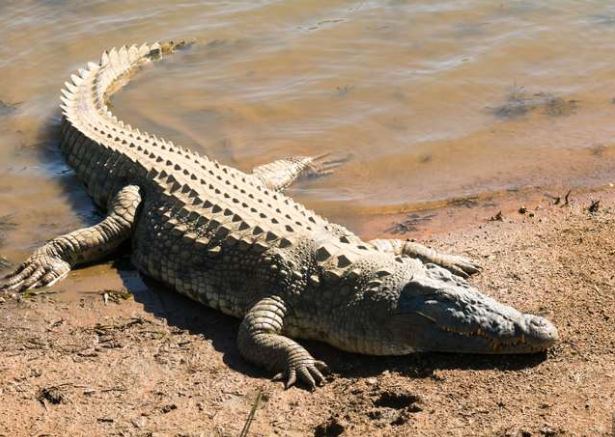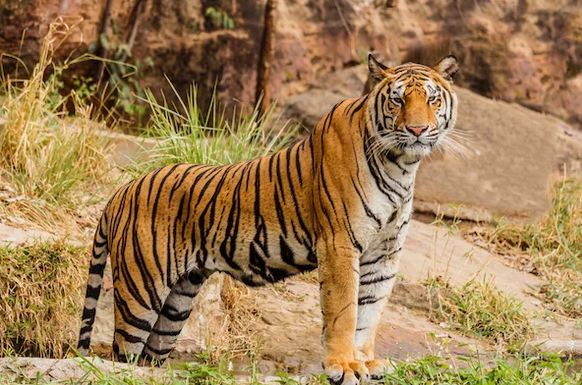Cold-blooded Animals (Poikilotherms/Ectotherms)
Cold–blooded animals can also be referred to as ectotherms or poikilotherms. These are animals that lack an internal physiological mechanism to regulate their body temperatures internally; therefore, their temperature is not constant and varies according to the temperature of the surrounding environment. In hot environments, their blood can get much warmer than that of the warm-blooded animals in the same environment. Most of these species are found in areas where the temperature is more or less stable.
Cold-blooded animals can be either terrestrial or aquatic. To regulate their temperature, cold-blooded animals have behavioral adaptations that help them in this regard, some of the behavioral adaptations include, basking perpendicular to the sun rays to get warm, and when they want to cool down they lie parallel to the sun, or keep their mouth open or seek shade.
Examples of Cold-blooded animals include:
- Reptiles (snakes, lizards, turtles, tortoise, alligators and crocodiles).
- Amphibians (Frogs, toads and salamanders).
- Fish (sharks, tilapia, goldfish, Guppy, Wels catfish, zander).
- Some Insects (Bumble bees, dragonflies and moth).
- Arachnids (Spiders, Scorpions, acari, harvestmen, ricinulei, schizomida, plesiosiro).

What You Need To know About Cold-blooded Animals
- Cold-blooded animals also referred to as poikilotherms or ectotherms are the organisms that regulate their body temperature in accordance to the changes or fluctuations in the surrounding temperature in the environment.
- Cold-blooded animals require less energy to maintain their body temperature, therefore they require less amount of food.
- Cold blooded animals have developed various behavioral thermoregulation mechanisms for instance, seeking shade to decrease body temperature, basking in the sun to increase body temperature, changing body color etc.
- The temperature of the body is dependent on the temperature of the surrounding environment i.e body temperature varies with surrounding temperature.
- Cold blooded animals move slowly for regulation of the internal temperature.
- Cold blooded animals show hibernation (winter sleep) and aestivation (summer sleep).
- They cannot survive in environment with extreme temperatures especially extreme cold.
- Metabolic rates of cold-blooded animals changes with the fluctuations in environmental temperature.
- Cold-blooded animals, do not produce heat within their body, they always gain energy in the form of heat to regulate body temperature.
- Have a comparatively low metabolic rate.
- Cold-blooded animals usually live in an environment of constant temperature for example in tropics, rivers, sea or oceans.
- Examples of cold blooded animals include: Fish, Reptiles, Amphibians, and Insects etc.
Warm-blooded Animals (Homeotherms/Endotherms)
Warm-blooded animals can also be referred to as endotherms or homeotherms, these animals generate heat internally and have a thermoregulatory system that maintains a constant body temperature largely independent of their surrounding environment. They also tend to maintain the same temperature throughout their lifetime. Warm-blooded animals use most of the food they eat to convert it to energy to stay warm, with the help of mitochondria found in each cell.
Warm-blooded animals can be either terrestrial or aquatic. To regulate their temperature, warm-blooded animals employ both behavioral adaptations and internal physiological mechanisms. For example, when they get too hot, some pant or sweat, some also cool off by moving into a shaded area or by getting wet. Warm-blooded animals can also shiver to generate more heat when they get too cold. Some like birds migrate from colder to warmer regions in the winter.
Examples of warm-blooded animals include:
- Sea Mammals (whales, seals, walruses, manatees and dolphins).
- Other mammals (dogs, pigs, lion, elephants, cow, sheep, goats and zebras).
- Primates (humans, apes and monkeys).
- Cats (tigers, cheetahs and domestic cats).
- Rodents (rats, beavers and chipmunks).
- Weasels (badgers and meerkats)

What You Need To Know About Homeotherms/Warm-Blooded Animals
- Warm-blooded animals are also referred to as Homeotherms or endotherms are animals that are able to maintain a constant body temperature irrespective of the temperature of the external surrounding environment.
- They require more amount of energy to regulate their body temperature and therefore their food requirement needs is high.
- Warm-blooded animals regulate heat mainly by metabolic processes and adaptive mechanisms such as sweating, burrowing, changing body surface area to volume ratio, insulation, panting, migration etc.
- The temperature of the body is independent of the temperature of the surrounding environment. The body temperature of warm-blooded animals is usually between 35-40 degrees Celsius.
- Warm blooded animals move fast and loose significant amount of energy to keep their muscles warm.
- Warm blooded animals rarely show hibernation and aestivation.
- They are easily adaptable to any environment and temperatures.
- Fluctuations in environmental temperature do not greatly affect the metabolic rate of warm blooded animals.
- They have a comparatively high metabolic rate.
- Warm-blooded animals can produce heat within their body.
- Warm-blooded animals usually live on land (Terrestrial environment).
- They do not produce heat within their body. They always gain energy in the form of heat to regulate body temperature.
- Examples of warm blooded animals include: Mammals and birds.
Also Read: Difference Between Vertebrates And Invertebrates
Difference Between Cold Blooded And Warm Blooded Animals In Tabular Form
| BASIS OF COMPARISON | COLD-BLOODED ANIMALS | WARM-BLOODED ANIMALS |
| Description | They are the organisms that regulate their body temperature in accordance to the changes or fluctuations in the surrounding temperature in the environment. | They are animals that are able to maintain a constant body temperature irrespective of the temperature of the external surrounding environment. |
| Energy Requirement | They require less energy to maintain their body temperature, therefore they require less amount of food. | They require more amount of energy to regulate their body temperature and therefore their food requirement needs is high. |
| Behavioral Mechanism | They have developed various behavioral thermoregulation mechanisms for instance, seeking shade to decrease body temperature, basking in the sun to increase body temperature, changing body color etc. | They regulate heat mainly by metabolic processes and adaptive mechanisms such as sweating, burrowing, changing body surface area to volume ratio, insulation, panting, migration etc. |
| Body Temperature | The temperature of the body is dependent on the temperature of the surrounding environment i.e body temperature varies with surrounding temperature. | The temperature of the body is independent of the temperature of the surrounding environment. |
| Movement | They move slowly for regulation of the internal temperature. | They move fast and loose significant amount of energy to keep their muscles warm. |
| Hibernation & Aestivation | They show hibernation (winter sleep) and aestivation (summer sleep). | They rarely show hibernation and aestivation. |
| Adaptation | They cannot survive in environment with extreme temperatures especially extreme cold. | They are easily adaptable to any environment and temperatures. |
| Effect Of Environmental Temperature On Metabolic Rate | Metabolic rates of cold-blooded animals changes with the fluctuations in environmental temperature. | Fluctuations in environmental temperature do not greatly affect the metabolic rate of warm blooded animals. |
| Rate Of Metabolism | Have a comparatively low metabolic rate. | They have a comparatively high metabolic rate. |
| Heat Generation | They do not produce heat within their body. They always gain energy in the form of heat to regulate body temperature. | They can produce heat within their body. |
| Habitat | They usually live in an environment of constant temperature for example in tropics, rivers, sea or oceans. | They usually live on land (Terrestrial environment). |
| Immunity | They have a weaker immunity. | They have a strong immunity. |
| Examples | Fish, Reptiles, Amphibians, Insects etc. | Mammals and birds. |